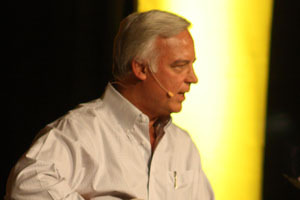Jack Canfield's Blog, page 4
July 11, 2011
The Heart to Lead
I am so proud of my wife, Inga.
In recent months she has been involved in a documentary entitled The Heart to Lead.
Dealing with a world in crisis...
{youtube width="560" height="349"}UF7AjwxVkZ0{/youtube}
Birthing a New Being...
{youtube width="560" height="349"}-uuoP3kdYfA{/youtube}
Movie Trailer:
{youtube width="560" height="349"}NU9C0zHMEEc{/youtube}
[image error]


June 17, 2011
Parents Do It All and Overlook the Obvious
 As parents we do pretty much anything to help our kids succeed. We give them a good education, food, clothing, iPods, a home, piano lessons, dance lessons, soccer lessons—and the list keeps going. We schlep our kids to endless practices and competitions. We get them through crises- big and small. We do our best to teach them to be good people, and we hope it sticks. Most of all, we love them no matter what.
As parents we do pretty much anything to help our kids succeed. We give them a good education, food, clothing, iPods, a home, piano lessons, dance lessons, soccer lessons—and the list keeps going. We schlep our kids to endless practices and competitions. We get them through crises- big and small. We do our best to teach them to be good people, and we hope it sticks. Most of all, we love them no matter what.
Kids are complicated! Syndicated columnist Erma Bombeck once wrote, "When my kids become wild and unruly, I use a nice, safe playpen. When they're finished, I climb out." One of the tools I teach in The Success Principles is to start with the end in mind in all the areas of your life—to use the creative power of visualization—and I found it works for parenting too. As Albert Einstein said, "Imagination is everything. It is the preview of life's coming attractions."
If you created a powerful vision around your parenting, what would it look like? What kind of family life would you like to have? Are you relaxed and resourceful even when life gets demanding? Can you see yourself remaining calm when the toddler's thrown spaghetti all over the walls, the older kids aren't listening, and your spouse is watching TV?
It pays to visualize. Harvard University researchers found that students who visualized before they performed a task had nearly 100 percent accuracy. Students who didn't visualize achieved only 55 percent accuracy. Almost all Olympic and professional athletes use visualization, including legendary golfer Jack Nicklaus, who once said, "I never hit a shot, not even in practice, without having a very sharp, in-focus picture of it in my head. It's like a color movie." So we know visualization works. And what parent doesn't need tools that work?
Another proven approach that works is to learn from others. Great role models speed up the learning curve significantly. One book that gives great models for parents is the award-winning book called If I Were Your Daddy, This Is What You'd Learn, in which thirty-five extraordinary men tell you how they raised and inspired their children. The book looks at fathering in ways no one's talking about—an in-the-trenches view. Instead of lecturing and theories, it tells true stories and with them, the shortcuts to great parenting. I loved the idea for this book so much that I wrote its foreword!
Having access to other perspectives and approaches on parenting is priceless! Without it, we limit what we can give our kids to the beliefs and behaviors we already know—the good and the not-so-good parts of our own childhood. Instead, If I Were Your Daddy… offers an insider's look at some great dads did, and with it, you—whether you're a mom or dad--can make up your mind to parent the same or to do things differently.
So in your devotion to your children—in the midst of doing it all—don't forget the most obvious… learn from others and don't reinvent the wheel. For certain, when you have great role models, it's a whole lot easier to visualize yourself at your very best—as the very best parent possible.
Jack
P.S. If I Were Your Daddy… has been voted "one of the best parenting/family books of 2011" by the Independent Book Publishers Association. I asked the author, Julia Espey, to offer a great deal, and here it is: Click Here
May 31, 2011
The 10 Most Important Minutes of Your Day
 Using Visualization to Harness the Power of Your Subconscious Mind
Using Visualization to Harness the Power of Your Subconscious MindJanuary 1 is traditionally a time for setting goals. But within weeks, many people lose their motivation and abandon their New Year's resolutions.
If you want to buck the trend and not only maintain your momentum, but also increase your chances of success, supplement your goal setting with visualization.
Harness the Subconscious Mind
Visualization – seeing the goal as already complete in your mind's eye – is a core technique used by the world's most successful people. Visualization is effective because it harnesses the power of our subconscious mind.
When we visualize goals as complete, it creates a conflict in our subconscious mind between what we are visualizing and what we currently have. Our minds are hard-wired to resolve such conflicts by working to create a current reality that matches the one we have envisioned.
Visualization activates the creative powers of the subconscious mind, motivating it to work harder at creating solutions. You'll also notice new levels of motivation and find yourself doing things that normally you would avoid, but that will take you closer to success.
The third way visualization boosts success is by programming the Reticular Activating System (RAS), which serves as a mental filter for the 8 million bits of information that are streaming into our brains at any one time. (To learn more about the RAS, refer to Principle 11 in The Success Principles.)
The RAS thinks in pictures, not words. Daily visualization feeds the RAS the pictures it needs to start filtering information differently. As a result, your RAS will start to pay attention to anything that might help you achieve your goals – information that it otherwise might ignore.
Live in the Moment
Although a daily practice of visualization is vital, we don't need to spend all day thinking about our goals for this technique to work. In fact, spending too much time in visualization can rob you of something essential – living in the moment.
Daily rituals help to establish the right balance between thinking about the future and living in the moment. Start by picking a time during which you'll review your goals and visualize your success. Ideally, do this twice a day – first thing in the morning and right before you go to bed. The process typically will take 10 minutes or less.
If you meditate, do your visualizations immediately after your meditation. The deepened state reached during meditation heightens the impact of visualization.
For greatest effect, read your goals or affirmations out loud. After each one, close your eyes and create the visual image of the completed goal in your mind.
To multiply the effects, add sound, smells, and tastes. Most importantly, add the emotions and bodily sensations you would be feeling if you had already achieved your goal. Research has revealed that images or scenes that are accompanied by intense emotion will stay locked in our memory forever. The more passion, excitement and energy we muster during visualization, the more powerful the results will be.
Once you have visualized each goal as complete, it's time to release. Let go of your goals, and spend the rest of your day being in the present moment.
Be Present Instantly
An easy way to instantly become present is to focus on your bodily sensations. It's impossible to focus on our bodies and be in the past or the future at the same time.
For example, focus on your left foot right now. What are you feeling? Pay attention to the sensation for a minute. Then notice what you're feeling in your right foot, and spend a few moments really feeling the sensation. If you were able to pay attention to your feet, congratulations. You were absolutely present.
If you find your mind drifting to the future throughout the day, let go of any fears or worries that arise. Shift your thoughts to what you want the future to look like when you get there. Then bring your awareness back to the moment.
As the saying goes, "Today is a gift—that's why it's called the present." Use visualization to achieve your goals, but invest the majority of your time enjoying the gift of today.
Overwhelmed By Your Goals? Discover 3 Questions to Maintain Momentum
 The new year kicks off with high expectations and motivation. But by early February, momentum slows. A sense of overwhelm is often the source of friction that slows the progress of achieving our goals.
The new year kicks off with high expectations and motivation. But by early February, momentum slows. A sense of overwhelm is often the source of friction that slows the progress of achieving our goals.Some people become overwhelmed because they set too many goals. Others find that the size of their goals paralyzes them. The solution is to set realistic goals and prioritize where you spend your time.
What Is Your Motivation?
The ideal goal is one that forces you to grow to achieve it, yet is not so big that it seems impossible. For some people, a big goal is adopting a consistent exercise program. For others, "big" is as expansive as ending world hunger. Each person has a unique threshold for what will stretch them.
Start by reviewing your list of goals and questioning your motivation for setting each. If we approach goal setting with the wrong mindset, it can be tempting to dismiss our small or highly personal goals as unworthy when compared with goals set by others. In an effort to feel better about ourselves and our goals, we tend to abandon the goals that bring us great joy in favor of goals that look and sound good.
Did you set a goal of writing a book, starting a business, or ending world hunger because that's what you really want? Or did they make it on your list because you thought they'd make you look good to others? If you discover that you set goals only because you thought they were more worthy, remove them from your list.
Is Your Goal Realistic?
Another way we can become paralyzed is by setting unrealistic goals. For example, consider the goal that I often hear from entrepreneurs: Generating $1 million in revenue in the next year. If your business is already generating $350,000 a year, tripling your revenue is a goal that will stretch you. However, if you have been unemployed for three years and are only launching a new business this year, thinking that you'll make $1 million in a year is unrealistic. Without the infrastructure, relationships, products and systems in place, achieving that big of a target may not be impossible, but it is unrealistic.
If you find a goal that is unrealistic, one solution is to set milestone goals that you'll achieve on the way to conquering your big goal.
Raymond Aaron, a world-renowned expert on goal setting and member of my Transformational Leadership Council, teaches us to set three levels of goals:
Minimum. What is the minimum level you need to establish a strong foundation? This might be creating $100,000 in business revenue.
Target. Once you've establish a foundation, what is a milestone goal that will stretch you? This might be to generate $500,000 in business revenue – a point at which you'll have abundant income to invest in your company's growth, as well as reward yourself as an owner.
Outrageous. This is the level that looks unrealistic from where you are starting, but that is possible as a long-term goal. In the example I used earlier, it would be to generate $1 million in revenue.
Do You Have Too Many Goals?
When the source of overwhelm is the number of goals you're trying to achieve, the solution is simple: Focus on fewer goals at one time.
One way to prioritize our goals is to compare them one by one. Imagine that you have four goals. Consider goal one and goal two. If you could only do one of them, which is most important to you? Now take the "winner" – let's say it's goal one – and compare it to the next goal on your list. Is goal one still the winner, or is it less important than goal three? Go through this process until all of your goals have been prioritized in their order of importance to you.
A second way to prioritize your goals is to create a matrix of six columns. List your goals down the left side of the page in column one. In the remaining columns, answer these questions about each goal:
Column 2: How much money could I make if I achieve this goal?
Column 3: What impact will achieving this goal have on the world?
Column 4: How many hours will it take to achieve this goal?
Column 5: How many people need to be involved to achieve this goal?
Column 6: On a scale of 1 to 10, with 1 representing absolute joy and 10 representing pain, how much happiness will achieving this goal bring me?
By completing the matrix, we're able to easily see which goals will generate the most money, impact and happiness as a return on our investment of time and energy.
Dreaming Big IS Good
Setting lots of goals – including what I call Big, Hairy Audacious Goals – are the mark of a successful person. Use these three questions to ensure that you can dream big without becoming paralyzed by the size of your dreams.
If you enjoyed this article, you'll LOVE Jack's revolutionary new mentoring resource - it's affordable, powerful, interactive, and fun! Click through to learn more.
Pruning Relationships that Don't Serve You
 Everything we want to achieve in life involves relationships. While it's important to learn how to build successful relationships, it's equally valuable to choose wisely when determining which connections to nurture.
Everything we want to achieve in life involves relationships. While it's important to learn how to build successful relationships, it's equally valuable to choose wisely when determining which connections to nurture. Drop the Anchors
Achieving goals and greater levels of success require energy – sometimes an enormous amount. Negative people are like psychic vampires. They drain us of the precious energy we need to grow and achieve, making relationships with these individuals toxic to success.
Until we reach the point in our self-development where we no longer allow people to affect us with their negativity, it's best to avoid toxic people at all costs. They will hold us back with their victim mentality and mediocre standards.
To identify which relationships are draining you, make a list of all people you spend time with on a regular basis. Go through the list and put a minus sign (-) next to the people who are negative and toxic. Put a plus sign (+) next to the people who are positive and nurturing.
Then stop spending time with the people on the negative list! If you don't believe that is possible – for example, if you are surrounded by negative people at work – do your best to dramatically decrease the amount of time you spend with them.
Identify Your Best Investments
Another way that relationships can drain our energy is when we feel overwhelmed by the number of relationships we have to maintain.
The first thing to explore is the feeling of "have to." Remember, there are no "have to's" or "shoulds" in life. There are only "choose to's." We get to choose where we invest our time and energy – and that includes determining which relationships we want to maintain.
"Have to" indicates that our motivation to maintain the relationships is based on fear. But to create greater success, we want to make decisions that are motivated by joy and excitement, as well as our purpose and goals.
We are equipped with a handy inner guidance system that tells us when we are making decisions that are in alignment with our higher good: Joy. When we are not spending a lot of time feeling joyful, it is a clear sign that we are off course.
Review your list of relationships again, this time with a different set of criteria. Identify the people who bring you the greatest joy, as well as financial and professional success. Which relationships are critical to your bottom line? Which people are you most excited to spend time with? Which people are most important for you to keep in touch with? These are the relationships to cultivate.
Dan Sullivan, president of the Strategic Coach, teaches his clients to identify their top 20 relationships, as well as a "farm team," which are 20 additional relationships that should be nurtured as future additions to the Top 20. Create this list for yourself, using joy as the measuring stick for personal relationships and bottom-line success for professional relationships.
Once your key relationships are identified, put the names into a chart, with the names prioritized in the first column. In the second column, add contact information so that it is readily available when you want to reach out to one of these key contacts. In the third column, answer the question, "What result(s) do I want to achieve with this person in the next 90 days?" Do you want them to hire you? Attend your seminar? Buy your book? Send referrals to you? Use this chart to guide your actions over the next three months as you nurture the key relationships.
You Get to Choose
In business particularly, you may feel that you are required to stay connected with more people than you would normally choose.
Remember that you get to choose not only which relationships you want to nurture, but also how close each relationships will be and how you will stay connected. More than 235,000 people around the world have subscribed to my mailing list to stay in touch with me. I can't develop personal relationships with everyone, of course. I choose to stay connected with my subscribers via tools such as my blog, e-zine and Inner Circle Club.
As world-renowned marine artist Wyland once said, "There are two types of people – anchors and motors. You want to lose the anchors and get with the motors because the motors are going somewhere and they're having more fun. The anchors will just drag you down." Carefully choose the relationships in which you invest your precious time and energy to ensure that your success isn't slowed … and so that you experience a positive return on your investment.
Structure Actions Around Your Core Genius
 When I talk to people who have a hard time achieving goals, one of the most common excuses I hear is "but I don't have enough time." If you can't find extra time to invest in the pursuit of your goals, it's time to reprioritize your responsibilities.
When I talk to people who have a hard time achieving goals, one of the most common excuses I hear is "but I don't have enough time." If you can't find extra time to invest in the pursuit of your goals, it's time to reprioritize your responsibilities.Successful people know that to achieve their goals and greater levels of accomplishment, they must structure their lives to maximize time spent on their core genius. Your core genius is the one thing that you love to do because it's effortless and a whole lot of fun. And if you could make money doing it, you'd make it your lifetime's work.
In most cases, your core genius is directly tied to your passions and life purpose. My core genius lies in the area of teaching, training, coaching and motivating. Another core genius is writing and compiling books. Along with my co-author Mark Victor Hansen, I have written, co-authored, compiled, and edited more than 100 books.
Successful people make their core genius a priority, delegating everything else to the rest of their team. Compare that to other people who go through life doing everything, even the tasks they're bad at or that could be done more cheaply, better, and faster by someone else. They can't find the time to focus on their core genius because they fail to delegate even the most menial duties.
When you delegate the grunt work (the things you hate doing or those tasks that are so painful, you end up putting them off), you get to concentrate on what you love to do. You make faster progress on your goals, and you get to enjoy life more.
So why is delegating routine tasks and unwanted projects so difficult for most people?
Surprisingly, most people are afraid of looking wasteful or being judged as being above everyone else. They are afraid to give up control or reluctant to spend the money to pay for help. Deep down, most people simply don't want to let go.
Others simply have fallen into the habit of doing everything themselves. "It's too time consuming to explain it to someone," they say. "I can do it more quickly and better myself anyway."
Delegate Completely
One of the strategies I use and teach is complete delegation. This means that you delegate a task once and completely, rather than delegating it each time it needs to be done.
When my niece came to stay with us one year while she attended the local community college, we completely delegated the responsibility of grocery shopping to her. We told her she could have unlimited use of our van if she would buy the groceries every week. We provided her with a list of staples that we always wanted in the house (eggs, butter, milk, ketchup, and so on), and her job was to check every week and replace anything that was running low.
In addition, my wife planned meals and let her know which items she wanted for the main courses (fish, chicken, broccoli, avocados, etc). The task was delegated once and saved us hundreds of hours that year that were instead devoted to writing, exercise, family time, and recreation.
Where Do You Spend Your Time?
Most entrepreneurs spend less than 30% of their time focusing on their core genius. In fact, by the time they've launched a business, it often seems entrepreneurs are doing everything but the one thing they went into business for in the first place.
Many salespeople, for example, spend more time on account administration than they do on the phone or in the field making sales, when they could hire a part-time administrator to do this time-consuming detail work.
Most female executives spend too much time running their households, when they could easily and inexpensively delegate this task to a cleaning service or part-time mother's helper, freeing them to focus on their career or spend more quality time with their family.
Don't let this be your fate. You can trade, barter, pay for and find volunteers to help with almost everything you don't want to do, leaving you to do what you are best at, and which will ultimately make you the most money and bring you the most happiness.
Become a Con Artist
Strategic Coach Dan Sullivan once stated that all entrepreneurs are really con artists. They get other people to pay them to practice getting better at what they love to do.
Consider speaker Anthony Robbins. People pay him big money to practice his core genius. He's arranged his life to maximize the amount of time that he is engaged in his core genius. He spends time doing what he loves, and the better he gets, the more money he earns.
Of course, most of us are not quite yet at the level of Tony Robbins. But we can take a cue from his level of focus.
For the next week, take note where you spend your time. What duties do you perform out of habit? Which do you do because you don't want to take the time to delegate it to someone else? Finally, how much time do you spend on your core genius … and how many more hours could you invest in this area if you delegated some of your responsibilities?
Achieving greater success and joy in life starts by identifying your core genius. Delegate everything else so you can focus on what you love to do.
The Power of Determination
 Taking action is essential if you want to achieve your goals, dreams and desires. To ensure that you stay in action, one of the most important qualities you must develop is persistence.
Taking action is essential if you want to achieve your goals, dreams and desires. To ensure that you stay in action, one of the most important qualities you must develop is persistence.
During your journey to greater success, you will encounter roadblocks, hardships and challenges. There will be times when you will want to quit, give up, and go back to doing something else. The one quality that will guarantee your success is the willingness to stick with it, to see it through to the end and to refuse to settle for anything less than your dream.
Be Willing to Pay the Price
Achieving goals and dreams usually requires some level of sacrifice. It might mean putting everything in life on hold in favor of working toward your dreams, investing all of your savings, or giving up a few hours of sleep each night. Many people proclaim to want to achieve their goals, yet are unwilling to pay the price it takes to make their dreams a reality.
No one knows this better than Olympic athletes. According to John Troup, writing in USA Today, "The average Olympian trains four hours a day at least 310 days a year for six years before succeeding. Getting better begins with working out every day. By 7:00 AM most athletes have done more than many people do all day."
Although becoming an Olympic athlete is probably not in your future, you can become world class in whatever you do by putting in the disciplined effort to excel at your profession, craft or trade.
However, before you can choose to pay the price, you must know what the price is. If you don't know what will truly be required to make your dreams a reality, investigate what it will take to achieve your desired goals. Research the costs other people have had to pay to achieve dreams similar to yours. You may even want to interview these individuals to discover the sacrifices they had to make along the way.
You may find that some costs are more than you want to pay. Only you can decide what is right for you and what price you are willing to pay.
But if the price is something you are willing to pay, commit yourself to achieving your dream – no matter what it takes. The willingness to do whatever is required is the magic ingredient that helps you persevere in the face of challenges, setbacks, pain and even personal injury.
Adversity and Discouragement Is Inevitable
No matter how well you plan and how well you execute your plan, you are bound to meet with disappointments, setbacks and failure along the way to your ultimate triumph. Sometimes, you will encounter what seem like overwhelming odds. At other times, the Universe will test your commitment to the goal you're pursuing.
Adversity is a great teacher. It gives you the opportunity to develop your inner resources of character and courage, requiring that you learn new lessons, develop new parts of yourself, and make difficult decisions.
Whenever you confront an obstacle or run into a roadblock, brainstorm three ways to get around it, over it, or through it. There are a number of ways that will work, but to find them, you must first look for them.
The longer you hang in there, the greater the chance that something will happen in your favor. No matter how hard it seems, the longer you persist, the more likely your success will be.
As Confucius wrote more than 4000 years ago in China, "Our greatest glory is not in never falling, but in rising every time we fall."
© 2011 Jack Canfield
Clearing Clutter Increases Success
 Our physical spaces are filled with dozens of minor distractions and irritants, such as stacks of unread books, scuff marks on the wall, and closets filled with unused items. For most people, these things are like gnats – annoying, but generally insignificant and easily ignored.
Our physical spaces are filled with dozens of minor distractions and irritants, such as stacks of unread books, scuff marks on the wall, and closets filled with unused items. For most people, these things are like gnats – annoying, but generally insignificant and easily ignored.
Rarely do we recognize them for what they really are – potent threats to our productivity, energy, concentration and peace of mind.
For those of us committed to achieving greater success in our lives, a cluttered physical environment produces three negative consequences:
1. You feel drained. If there are things to do everywhere you look, your mind constantly keeps thinking "I need to fix that." Eventually, you to feel drained, anxious, irritable, and overwhelmed. To cope, we have to put blinders on and overlook the distractions.
2. Problems spiral out of control. We often overlook irritations for the short-term gain of being able to continue with our daily routine. The danger, however, is that some problems with grow worse with lack of attention. The chip in the windshield that could have been fixed in 30 minutes grows to a crack that requires replacement of the entire windshield.
3. You miss important clues and ideas. It's impossible to selectively numb out your awareness, ignoring only the minor distractions in your physical space while paying close attention to everything else. This is perhaps the biggest danger for success-minded people. Our most powerful insights often manifest in gut feelings, fleeting thoughts and subtle cues. Numbing out to our cluttered physical environments makes us oblivious to these clues, as well.
Physical Space Impacts Mental Space
Seemingly small irritations and distractions also have a dramatic impact on our mental state. It's common for people who feel overwhelmed by their physical clutter to go into a state of resignation. When you have a sense that you can't control the little things – such as quickly finding a stapler when you need it – then it becomes easy to tell yourself that there's no way you can have the other, bigger things that you want, such as a better car, bigger house, prestigious job, or loving relationship.
The good news is that the same concept works in reverse. When you do recognize that you can control little things, such as the squeak every time you open your front door, you recognize that you can control the bigger things in life, too. Taking action to manage irritations, distractions and clutter builds your confidence in your ability to achieve success, regardless of form.
3 Ways to Deal with Clutter
There are three ways to change any environment: add something to it, take something out of it, or modify it in some form.
Go through your environment and figure out what is irritating and distracting you. Ask yourself how it needs to be fixed. Then think about who you might be able to delegate all or part of the task to. One reason that to-do items accumulate is that we feel like we have to do all of the work ourselves. One of the key strategies for getting more done is to master the art of delegation.
To help you move forward with this process, I've posted an "Irritations & Tolerations" worksheet on my blog. Use this tool to identify and create an action plan for handling your irritations and tolerations.
Next, scan your environment to identify elements that need to be removed completely, as well as items that can be brought in to increase the energy in your space. For example, you might find that removing the television or computer from your bedroom makes your sleeping space more relaxing and peaceful. On the other hand, you might find that adding a conference table to your office gives you an inviting place for creative work, while adding plants makes you feel calmer and connected to nature.
Spotting "Good" Clutter
Remember that all clutter is not bad. For many people, clutter is part of their creative process.
When in the midst of creation – such as writing an article, developing a presentation, mapping out a business strategy or creating a product – they pull out resources like books, clippings, articles and notepads. More artistic types might fill their work spaces with tools of their particular trade.
The litmus test to use in determining whether your clutter needs attention is how you feel. If you feel inspired, the clutter is serving you and contributing to your creative expression. If you feel contracted, drained, anxious or stressed, the clutter needs to be tamed.
Environments control us, but it's important to recognize that as human beings, we are one of the few animals that can control their environments.
*Click Here to Download the Irritations and Tolerations Worksheet
One Approach to Recent World Events
 When disasters like the earthquakes, tsunamis and release of radiation from the Fukushima Daiichi Nuclear Power Plant in Japan happen, we are all confronted with our own fears of natural disasters. Living in California, there is always the possibility of earthquakes and tsunamis, mudslides and flooding, and forest fires which sweep through our forests often consuming hundreds of homes. In other parts of the country we live with the threat of hurricanes, tornadoes, flooding rivers, ice storms, wildfires, and oil spills. At times like these we are reminded just how fragile life on this planet can be. And that reminder can be scary.
When disasters like the earthquakes, tsunamis and release of radiation from the Fukushima Daiichi Nuclear Power Plant in Japan happen, we are all confronted with our own fears of natural disasters. Living in California, there is always the possibility of earthquakes and tsunamis, mudslides and flooding, and forest fires which sweep through our forests often consuming hundreds of homes. In other parts of the country we live with the threat of hurricanes, tornadoes, flooding rivers, ice storms, wildfires, and oil spills. At times like these we are reminded just how fragile life on this planet can be. And that reminder can be scary.
When you add the social upheaval and the often brutal reaction from dictators in the Middle East and elsewhere around the world, the potential terrorist attacks, the financial instability in the world, global warming, environmental degradation, and so many more local challenges, it is no wonder that there is a lot of anxiety and fear in the world. And as I am always teaching, you cannot make your best decisions when you are afraid. Nor can you make them when you are in a state of anger toward the people or that you believe are creating the problems or not solving them the way that you think they should be.
During the recent Japanese nuclear crisis I watched many of my family members and friends in California move into some pretty deep places of fear—buying up potassium iodide pills and other remedies, and several even leaving the state for awhile. There is nothing wrong with taking intelligent precautions and making preparations for taking care of yourself and your family, but, as it turned out, there was very little factual evidence that anything was happening that was unsafe.
Granted, none of us want to be exposed to any more radiation than is necessary—what we are normally exposed to with x-rays, the new airport screening monitors, flying at high altitudes in airplanes, etc. But what I think we really need to protect ourselves from is fear and panic. We need to be part of the solution to the world's problems, not part of the problem caused by our own fear and our own beliefs that something shouldn't be the way it is. The truth is that most of our pain in life comes from resisting the way things are. We think reality should be different than it is. We think others shouldn't act the way they do. And we deny, resist or try to change the feelings we don't want to feel.
As I was thinking about all of this, my friend Hale Dwoskin, who teaches the Sedona Method, sent me a link to his new blog on the Huffington Post. Included in the blog was a link to a video on YouTube of him leading a "Release for the World." In this 12-minute video he leads participants through a process of releasing any emotions that come up around thinking the world and what is happening in it should be different than it is. Obviously there are actions that support peace, harmony, love, cooperation, social justice, environmental sustainability and conscious evolution that we can participate in, but we will know what is our part to do and what is for others to do, and we will not add to more conflict in the world, when we are coming from a place of being centered, in touch with our essence, in touch with our true inner guidance—which we are not in touch with when we are acting or reacting out of fear, judgment and anger.
I participated in the process Hale led on the video, and afterward I found myself much more centered and connected with my true self and clearer about what actions I would take to help the people in Japan and also in help contribute to environmental sustainability. I also felt moved to transcribe the process so that I could lead it in my upcoming seminars and workshops. I then sent a copy to all my Advanced Train the Trainer students to use in their workshops and trainings. And now I am including it below along with the original video that Hale posted on YouTube.
I hope you'll take advantage of this valuable process, and also share it with other family members, friends, and colleagues.
As always, I send you lots of love and the invitation to continue working toward creating a world that works for everyone. Just follow your heart and do what feels right for you. If everyone tunes in and does what they are personally called to do, I believe everything that needs to be done will be done. In times like these I find it valuable to remember this piece of wisdom that I learned many years ago:
Be a teacher to those below you,
a fellow traveler to those beside you,
and a student to those above you.
Let me end with an excerpt from an e-mail which was forwarded to me by an American woman who was teaching English in Sendai (one of the hardest hit towns in Japan) a few days after the earthquake and tsunami struck.
"During the day we help each other clean up the mess in our homes. People sit in their cars, looking at news on their navigation screens, or line up to get drinking water when a source is open. If someone has water running in their home, they put out a sign so people can come to fill up their jugs and buckets.
…there has been no looting, no pushing in lines. People leave their front door open, as it is safer when an earthquake strikes. People keep saying, 'Oh, this is how it used to be in the old days when everyone helped one another.'
No one has washed for several days. We feel grubby, but there are so much more important concerns than that for us now. I love this peeling away of non-essentials. Living fully on the level of instinct, of intuition, of caring, of what is needed for survival, not just of me, but of the entire group.
…And the Japanese themselves are so wonderful. I come back to my shack to check on it each day, now to send this e-mail since the electricity is on, and I find food and water left in my entranceway. I have no idea from whom, but it is there. Old men in green hats go from door to door checking to see if everyone is OK. People talk to complete strangers asking if they need help. I see no signs of fear. Resignation, yes; but fear or panic, no.
…Somehow at this time I realize from direct experience that there is indeed an enormous cosmic evolutionary step that is occurring all over the world right at this moment. And somehow as I experience the events happening now in Japan, I can feel my heart opening very wide. My brother asked me if I felt so small because of all that is happening. I don't. Rather, I feel a part of something happening that is much larger than myself. This wave of birthing (worldwide) is hard and yet magnificent."
We are indeed all in this together—one humanity striving to survive and thrive in what often appears to be an uncertain world. We can do this much more elegantly, efficiently and appropriately when we are connected to our own true self, and not swept away in a tsunami of fear or futilely attempting to control that which we cannot.
{youtube width="600" height="300"}7WPih_5RbR8{/youtube}
"A Release for the Planet" Adapted from Hale Dwoskin and the Sedona Method
"We're going to do a release for the world. As you discover the truth of who you are, you begin to realize that there is really no separation between you and this lovely planet – all the people, animals, plants, and geography.
So, in this moment… could you just simply be what you are… and be what you are… and be what you are… And could you allow yourself to think about something about our lovely planet, planet earth, that may not be going exactly the way you would prefer. See if there is anything unfolding on planet earth right now that you are wanting to change or control. And if so, could you simply welcome that thing you are wanting to change or control and allow it to be here? And could you, just for now, let go of wanting to change or control that? …
And then could you allow yourself to hold the perfection in mind. Could you allow yourself to love planet earth because it is the way it is? … And then could you be open to that particular body mind, or whatever body minds are appropriate, to take conscious, supportive action to support our home world? Could you allow yourself to see the healing of the planet and all its species that call it home? …
And then could you call to mind anything else on planet earth that you would like to change or control, that you wish were different, that you think should be improved? … And can you welcome anything that that brings up inside of you? ... And could you, just for now, simply let that go … and hold the best vision or the solutions in mind and let the problems dissolve… and, as best you can, can you see the planet as already whole, already perfect, already in the healing process? … And then could you be open to that particular body mind or whatever other body minds are appropriate to getting into conscious supportive, creative action to allow and support that healing to unfold, and could you just simply see it as perfect now, simply love our planet, our home as it is? …
And then just think of something else, another thing on planet earth that you think has room for improvement, that that you wish someone would fix or change… And could you just simply welcome whatever that brings up inside you? … And then could you just simply let it go? … And could you be open to at least the possibility… that no matter how it appears now… there is hope for our home planet? That progress is already happening… Positive change is already unfolding exactly as it is or it should? … And could you be open to possibility that that particular body mind or appropriate body minds are already taking action to heal our earth? …
And could you love this planet in this moment as it already is. And in this moment could you allow the love that you are to shine? ... Notice how it is already bringing love and light to every cell in your body and mind… and it is spilling over to all other minds and all other bodies and all races … and all species… embracing all creeds, loving all as it is, supporting all … as it is. Being all as it is… And could you just simply shine as the light of love that you are? ...
And notice how you are already everywhere present … around and through this entire planet, and also notice … how you are shining love down on planet earth… as all space, and simply smile… at our home world. Let the love that you are bathe the entire planet... supporting all that is positive, all that is healing, all that knows the right way or the appropriate way… to allow for harmony… balance… and truth… and equality… and environmental sustainability… and peace. ... And in this moment, could you allow yourself to be the peace that you would like to see for planet earth? Could you allow yourself to be the solution? Could you simply allow yourself to be... and be… and be. ... And so it is.
Great! Thank you all for participating in that."
April 2011 Ask Jack Call
 I just got off another great Ask Jack Call. We talked about how to create environments that support your success, which is one of the most commonly overlooked areas of our lives. I answered some great questions, and also recommended completing some post-call homework: April 2011 Ask Jack Homework
I just got off another great Ask Jack Call. We talked about how to create environments that support your success, which is one of the most commonly overlooked areas of our lives. I answered some great questions, and also recommended completing some post-call homework: April 2011 Ask Jack Homework
If you happened to miss the call, you definitely want to check it out. It was packed with information to help you identify what's holding you back, the truth about how many environments affect your reality, and how to create supportive environments that nurture your dreams and goals. "Environments" is the theme for the month in the Inner Circle Club. If you aren't a member of the Club yet, click here for details on how to join.
We are now in the 4th month of a new year---how are you doing the your goals you set for yourself in the beginning of 2011?
Jack Canfield's Blog
- Jack Canfield's profile
- 1738 followers



